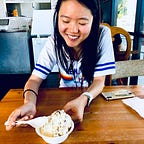C Mini — Project 1: Holding it all together: Structure, System, Form
First Class
We were supposed to bring to class something that inspires us, whether it be a poster, a book, a website, or a video.
I brought to class a Chinese movie poster I really like. Even though I’ve never seen the movie, I love the mood this poster conveys and I can get a sense of the genre just by looking at this poster. It’s interesting how it uses the color blue to create a serene and contemplating atmosphere, and how it uses value contrast to lead the viewer’s eye.
Some other posters by the same designer I also enjoy:
Class Discussions:
- entry/exit point — where do people start in a book? From the beginning or somewhere in the middle? Are there any indicators? Does it depend on what kind of book this is (informational vs narrative)?
- proportions of image vs text — what does this tell you about its audience?
- life span (magazine vs collection item) — how does this influence the design?
The GQ Presentation
Research
We first started off doing some basic research in regards to answering the five Ws (Who, What, When, Where, Why). We gathered these information in a shared Google doc.
What
- acronym stands for “Gentlemen’s Quarterly”
- International monthly men’s magazine
- Focuses on fashion, style, culture
- Wide variety of content: food, music, movies, cars, technology, style, architecture, social, politics, business etc.
- “Since 1957, GQ has inspired men to look sharper and live smarter with its unparalleled coverage of style, culture, and beyond. From award-winning writing and photography to binge-ready videos to electric live events, GQ meets millions of modern men where they live, creating the moments that create conversations.” (GQ website)
When
- Started as trades publication in NYC in 1931, originally named “Apparel Arts”, aimed at wholesale buyers/retail sellers (give advice to customers)
- Became available to the public in 1957
- “Apparel” dropped from the logo in 1958, established “Gentlemen’s Quarterly”
- Rebranded as “GQ” in 1967
- Publication increased from quarterly to monthly in 1970
- Bought by Conde Nast in 1983, started including articles beyond fashion
- British GQ began publication in 1988
- GQ began marketing towards younger readership (ages 18 to 30) in 2003 to compete with British “lad” magazines
Who
- Target audience: “well-off” male in their 20s and 30s
Why
This is where our narrative—the thesis that ties everything together comes in. After doing some initial research, we decided to focus our narrative on these elements of the GQ brand:
- Of the moment, engaged in culture
- Moving into the global market, becoming more diverse
- Evolving definition of masculinity, changing fashion
Presentation Outline
Since we focus on GQ always wanting to be on the edge of progress as a modern publication, we thought taking a closer look at its history at the beginning of our presentation would provide a lot of context to build a basis for our thesis.
After outlining what we want to talk about, we moved into Figma for some rough prototyping of the slides.
Figma
We used Figma primarily to figure out the rough layouts of our slides and the sequence they are in.
Somethings that we really focused on: using less words and more visuals (show, don’t tell), having a strong hypothesis & weaving it throughout our narrative
For a macro view of content structure, we had a hard time coming up with our infographics. One big problem was that our magazine had 277 pages, which was a lot of information to show on one slide.
We tried a variety of methods, some of which gave us headaches when we looked at it for too long. Below is what we decided on:
Even though it doesn’t show the individual pages, it tells viewers something about the placement of certain contents versus others.
Grids
For grids, we decided that each person would examine one type of article in terms of columns, gutters, margins, spatial zones, and markers. We wanted to show that GQ has a variety of different articles types, and that different designs were used in making each look really different.
Columns
Gutters
Since gutter width remain the same throughout, we decided to just briefly mention it in the column slide.
Margins
Spatial Zones
Markers
Feedback Round 1
We met with Jaclyn to run our rough prototype by her on the weekends. Our main takeaway from this conversation was that we should really nail down our thesis statement, so we can tie everything back to it.
So we came up with a rough thesis: GQ uses both macro and micro design decisions to convey its brand as progressive, trendy, and diverse.
We later changed the adjective “diverse” because we used it to communicate that GQ has a variety of contents, however the modern connotation seems to pertain more to racial issues. It was replaced with “sophisticated”, which we thought fit both GQ’s global reach and content variety.
Presentation Draft
Feedback Round 2
- add “thank you” slide at the end
- introduce ourselves at the beginning
- How does Apparel Arts’s brand identity relate to GQ’s brand today? It has always been progressive and trendy
- “trendy” has a negative connotation (a bit mocking)
- the title “summary” feels too formal for the last slide
Visual:
- grid analysis too hard to read (make things less opaque)
- can’t see three spreads on one slide very well
- header confusing (changes places)
- wish there were title slides for each section of the content
- overall look of the presentation is too feminine (pastel color palette, thin round typeface)
Delivery:
- be more enthusiastic
- don’t sound like reading a script
